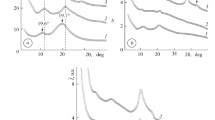By the methods of wide-angle X-ray diffraction and small-angle X-ray scattering, we study the specific features of the structural organization of pectin–Ag0–P4VP nanocomposites obtained under the action of constant electric fields. It is shown that, in the process of chemical reduction of Ag+ ions in polyelectrolyte–metal complexes, under the action of electric fields, we observe the formation of nanocomposites with higher contents of metallic silver than in the absence of the field. By the method of thermomechanical analysis, it is demonstrated that these materials have a much higher temperature of vitrification, a lower temperature of transition into the viscous-flow state, and a higher susceptibility to relative deformation.



Similar content being viewed by others
References
V. Demchenko, S. Riabov, N. Rybalchenko, L. Goncharenko, S. Kobylinskyi, and V. Shtompel', “X-ray study of structural formation, thermomechanical and antimicrobial properties of copper-containing polymer nanocomposites obtained by the thermal reduction method,” Europ. Polymer. J., 96, 326–336 (2017).
D. Wohrle and A. D. Pomogailo, Metal Complexes and Metals in Macromolecules: Synthesis, Structure, and Properties, Wiley-VCH, Weinheim (2003).
A. D. Pomogailo and V. N. Kestelman, Metallopolymer Nanocomposites, Springer, New York (2005).
A. A. Zezin, “Synthesis of hybrid materials in polyelectrolyte matrixes: control over sizes and spatial organization of metallic nanostructures,” Polymer. Sci., 58, No. 1, 118–130 (2016).
Y. Yan and J. Huang, “Corrigendum to ‘Hierarchical assemblies of coordination supramolecules,” Coord. Chem. Rev., 254, 1072–1080 (2010).
V. Demchenko, V. Shtompel’, and S. Riabov, “Nanocomposites based on interpolyelectrolyte complex and Cu/Cu2O core-shell nanoparticles: Structure, thermomechanical and electric properties,” Europ. Polymer. J., 75, 310–316 (2016).
V. L. Demchenko and V. I. Shtompel', “Structuring, morphology, and thermomechanical properties of nanocomposites formed from ternary polyelectrolyte–metal complexes based on pectin, polyethyleneimine, and CuSO4,” Polymer. Sci., 56, No. 6, 927–934 (2014).
V. L. Demchenko, V. I. Shtompel’, and S. V. Riabov, “DC field effect on the structuring and thermomechanical and electric properties of nanocomposites formed from pectin–Cu2+ –polyethyleneimine ternary polyelectrolyte–metal complexes,” Polymer. Sci., 57, No. 5, 635–643 (2015).
V. Demchenko, V. Shtompel’, S. Riabov, and E. Lysenkov, “Constant electric and magnetic fields effect on the structuring and thermomechanical and thermophysical properties of nanocomposites formed from pectin–Cu2+ –polyethyleneimine interpolyelectrolyte–metal complexes,” Nanoscale Res. Lett., 10, 479–485 (2015).
O. Kratky, I. Pilz, and P. J. Schmitz, “Absolute intensity measurement of small-angle X-ray scattering by means of a standard sample,” J. Colloid Interface Sci., 21, No. 1, 24–34 (1966).
V. L. Demchenko, “Specific features of the structural organization and thermomechanical properties of pectin–Ag0–P4VP nanocomposites formed under the action of constant magnetic field,” Fiz.-Khim. Mekh. Mater., 53, No. 4, 20–27 (2017); English translation: Mater. Sci., 53, No. 4, 444–452 (2017).
W. Ruland, “Small-angle scattering of two-phase systems: Determination and significance of systematic deviations from Porod’s law,” J. Appl. Cryst., 4, No. 1, 70–73 (1971).
R. Perret and W. Ruland, “Eine verbesserte Auswertungsmethode fur die Rontgenkleinewin-kelstreuung von Hochpolymeren,” Kolloid Z. – Z. Polymere, 247, 835–843 (1971).
G. Porod, “General theory,” in: O. Glatter and O. Kratky (editors), Small-Angle X-ray Scattering, Academic Press, London (1982), pp. 17–51.
Author information
Authors and Affiliations
Corresponding author
Additional information
Translated from Fizyko-Khimichna Mekhanika Materialiv, Vol. 55, No. 6, pp. 57–61, November–December, 2019.
Rights and permissions
About this article
Cite this article
Demchenko, V.L. Formation of Silver-Containing Polymeric Nanocomposites by the Reduction of Ag+ Ions in Polyelectrolyte–Metal Complexes Under the Action of Electric Fields. Mater Sci 55, 840–845 (2020). https://doi.org/10.1007/s11003-020-00377-2
Received:
Published:
Issue Date:
DOI: https://doi.org/10.1007/s11003-020-00377-2




